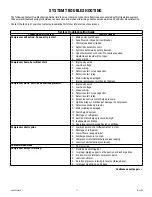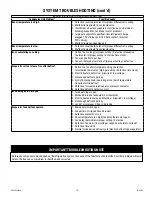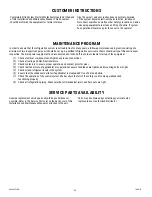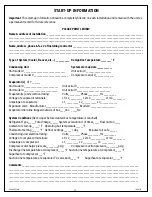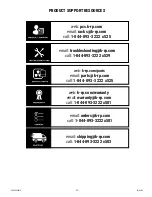
K90-KPCS-IM-2
18/04/22
- 16 -
When the system has been running trouble free for an extended time (two weeks or more) and design conditions are satisfied, the
following check list should be followed:
(1) Check that compressor
discharge and suction pressures
are operating within the allowable design limits for the
compressor. If not, take the necessary corrective action.
(2) Check the liquid line sight glass and expansion valve operation. If there is an indication that the system is low on
refrigerant, thoroughly
check the system for leaks before adding refrigerant.
(3) Check the
level of the oil
in the compressor sight glass (if so equipped). Add oil as necessary.
(4) The thermostatic expansion valve must be checked for
proper superheat settings
. The sensing bulb must have
positive contact with the suction line and should be insulated. Valves operating at a high superheat setting results
in low refrigeration capacity. Low superheat settings can cause liquid slugging and compressor bearing washout.
(Refer to the section on compressor and evaporator superheats)
(5) Check the
voltage and amperage
readings at the compressor terminals. Voltage reading must be within the
recommended guidelines. Normal operating amperages can be much lower than the compressor nameplate
values.
(6) To check the
high pressure control setting
it is necessary to build up the head pressure to the cut-out point of
the control. This can be done by stopping the condenser fan(s) (air cooled condensing units) or pump and
watching the pressure rise on a high pressure gauge to make sure the high pressure control is operating at the
setting.
(7) Check the
low pressure settings
by throttling the compressor shut-off valve and allowing the compressor to
pump
down. This operation must be done with extreme caution to avoid too sudden a reduction in crankcase
pressure, which will cause oil slugging and possible damage to the compressor valves. Close the valve a turn a
a time while watching the compound gauge for change and allowing time for the crankcase pressure to equalize
with the pressure control bellows pressure. The slower the pressure is reduced, the more accurate will be the
check on the pressure control setting.
(8) Recheck all
safety and operating controls
for proper operation and adjust as necessary.
(9) Check
defrost controls for initiation and termination settings
, and the length of defrost period. Set the fail
safe on the time clock at the length of defrost plus 25 %.
(10) If the system is equipped with winter head pressure controls (fan cycling or flooded valves),
check for operation
.
(11) Fill in the
Service Log
in the back of this Installation Manual.
SYSTEM OPERATIONAL CHECK LIST
















